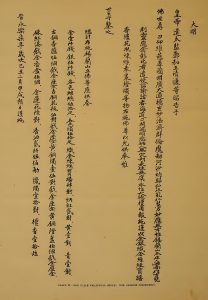
Galle (Sri Lanka). Stele of Zheng He (鄭和), transcription of Chinese portion. (Zenodo).
The inscription is engraved on a stone slab discovered in 1911 by H. F. Tomalin, the Provincial Engineer at Galle, in a culvert near the turn to Cripps Road within that town and afterwards moved to the Colombo Museum. The slab features inscriptions in three different languages, enclosed within a floral border: Tamil (top-left, IN03150), Persian (bottom-left, IN03151) and Chinese (right). The Chinese inscription is dealt with here.
Following the discovery of the slab, the Chinese inscription was transcribed and translated by Edmund Backhouse. Like the Tamil inscription, it is dated in the second month of the seventh year of Yongle (永樂), the Chinese emperor whose reign began in 1403. The text features praise and offerings dedicated by the Chinese emperor, through his envoys Ching-Ho and Wang Ch’ing Lien, to the Buddha. The other two inscriptions on the slab feature similar lists of offerings but the beneficiary is different in each case, being a Hindu cult deity in the Tamil text and an Islamic saint or shrine in the Persian. It therefore appears that, when the Chinese arrived in Sri Lanka, they made gifts of equal value to several different religious traditions of the region and registered these gifts on the same stele.
His Majesty, the emperor of the Great Ming dynasty has despatched the eunuchs Ching-Ho, Wang Ching-Lien, and other to set forth his utterances before the Buddha, the World-Honoured One, as follows:
“Deeply do we reverence you, Merciful and Honoured One, whose bright perfection is wide-embracing, and whose way of virtue passes all understanding, whose law enters into all human relations, and the years of whose great Kalpa (period) are like the sand of the river in number, you whose controlling influence ennobles and converts, whose kindness quickens, and whose strength discerns, whose mysterious efficacy is beyond compare!
“Whereas Ceylon’s mountainous isle lies in the south of the ocean, and its Buddhist temples are sanctuaries of your gospel, where your miraculous responsive power imbues and enlightens. Of late, We have despatched missions to announce our mandates to foreign nations, and during their journey over the ocean they have been favoured with the blessing of your beneficent protection. They escaped disaster or misfortune, and journeyed in safety to and fro. In everlasting recognition of your supreme virtue, We, therefore, bestow offerings in recompense, and do now reverently present before Buddha, the Honoured One, oblations of gold and silver, gold embroidered jewelled banners of variegated silk, incense burners, and flower vases, silks of many colours in lining and exterior, lamps and candles with other gifts, in order to manifest the high honour of our worship. Do you, Lord Buddha, bestow on them your regard!”
List of Alms bestowed at the Shrine of the Buddhist Temple in the Mountain of Ceylon as offerings.
1,000 pieces of gold : 5,000 pieces of silver : 50 rolls of embroidered silk in many colours : 50 rolls of silk taffeta, in many colours : 4 pairs of jewelled banners, gold embroidered, and of variegated silk : 2 pairs of the same picked in red : one pair of the same in yellow : one pair in black : 5 antique brass incense burners : 5 pairs of antique brass flower vases picked in gold on lacquer, with gold stands : 5 pairs of yellow brass candlesticks picked in gold on lacquer, with gold stands : 5 yellow brass lamps picked in gold on lacquer with gold stands : 5 incense vessels in vermilion red, lacquered gold picked on lacquer, with gold stands : 6 pairs of golden lotus flowers : 2,500 catties of scented oil : 10 pairs of wax candles : 10 sticks of fragrant incense.
The date being the seventh year of Yung-Lo (1410 A.D. sic) marked Chi ch’ou in the sixty years’ cycle, on the Chia Hsu day of the sixty days cycle in the second moon, being the 1st day of the month.
A reverent oblation.